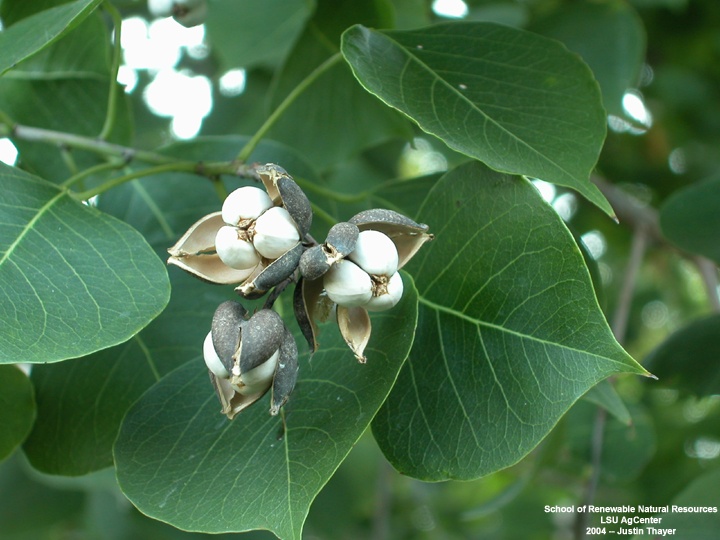
The Chinese Tallow tree is also called the Pop Corn Tree.

Chinese Tallow seed oil –Stillingia — is toxic. It has industrial uses, however.
Is it edible? Yes, no, maybe… The Chinese Tallow tree is both banned and championed. It’s edibility is also bound to why it is even in the United States to begin with. The tree was imported by none other than Ben Franklin (well… he sent some seeds to a friend.) The purpose was to use the white external seed fat for making candles which beef suet, tallow, was once used for. Hence the tree’s name in English. In theory that small coating of saturated fat on the outside of the seed is edible. It is also very stable. But there are two problems. It can be very difficult to remove and inside the seed there is an oil toxic to humans. So the fat and the oil should not mix. Some people have experimented with crushing the entire seed and heating the mash thus melting the saturated fat along with releasing the toxic oil. When they settle the edible fat and the non-edible oil are separated. In China, where the tree is valued, they steam the white saturated fat off. The tree, while an invasive species in some areas of North America — such as Florida — is being considered as a good candidate for bio-fuel. You can read my article about it here about it here. A later magazine article about the species is here.
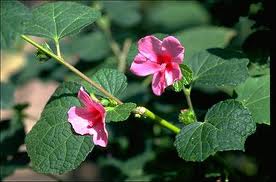
Caesarweed blossoms are edible.
Caesarweed is a common sight locally but right now it is being a seasonal extrovert and blossoming profusely. Like the Chinese Tallow tree above, Caesar Weed is another plant intentionally imported for industrial use, in its case making fiber for burlap bags and the like. It’s not strong enough to make a sturdy rope like Skunk Vine (which is also blossoming now and was imported to make rope.) But if thrown in water and allowed to rot for a few weeks long blast fibers are left over. The tasteless flowers are edible, the seeds can be ground and used like corn starch, and the leaves have medicinal uses besides being a famine food. They are hairy and upset the tummy. You can read about Caesar Weed here or see a video I did on it here.
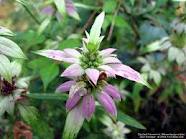
Monarda punctarta
Horsemint is happy right now. It begins to be seen in August, usually flourishes in September, and hangs out till October. However, it’s still going strong this first week in October and oddly can sometimes a specimen or two can be found way out of season during warm weather. Horsemine is in a large family of mints in the Monarda genus. Back home it was called Oswego Tea. As far as I know they are all useable. I would say edible but one does not tend to eat a lot of mint. It is used for flavoring, teas, and the like. Horsemint likes dry, sandy soil and growing among other weeds. It usually creates a stand of its own. It is also a species some folk would like to make illegal. To read why, go here. To see my video go here.
Last week’s newsletter published a mushroom mystery seen in Port Orange, which is a few miles south of Daytona Beach on the coast. A palm stump had what appeared to be Oyster Mushrooms on them. There are at last three edible Oyster mushrooms locally. While they do have a general season they are more discovery than a mushroom you can expect to find regularly. This time of year one expects some small ones with lilac-colored spore prints and later in the cooler months larger Osyters with white spore prints. My first guess was Pleurotus pulmonarius. Andrew Gerren agreed:
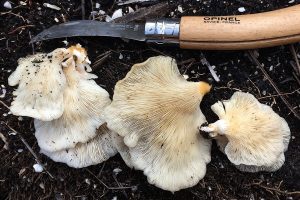
Pleurotus pulmonarius, Oyster Mushrooms.
“I believe the specimen is indeed an oyster. Likely Pleurotus pulmonarius, commonly known as the phoenix oyster or Italian oyster. It has a tendency for hardwoods/deciduous softwoods but unlike most other oyster species it can be found/cultivated on conifers. Cool to find it on palm! They are typically smaller and whiter than ostreatus, but can get pretty big and still be a greyish-brown depending on environmental conditions. It might seem silly but a good way to ID oysters is by smell, oysters seem to have a rather distinct smell. But decurrent, tightly packed, blade-like gills are great indicators of an oyster. The specimen on the left is a good demonstration of the gills running down the stem to the base/attachment point. The lilac/white spore print is good confirmation as well. This time of year I would have usually thought ostreatus but the fact that it is florida and a palm tree I would say pulmonarius. The size and color also point to pulmonarius. All oysters that I am aware of are edible though. Its an easy mushroom to cultivate as well.”
This is also a good time and place to reiterate that Ringless Honey Mushrooms are being reported here and there though the usual season’s time is the first two weeks in November. It can flush any time of year but usually it is around November. I found a bunch in Gainesville Saturday last but since I was on a multi-day fast there was no opportunity to eat them.
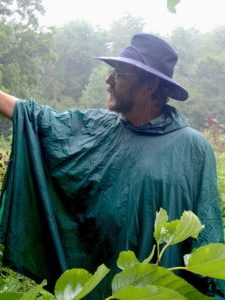
Classes are held rain or shine or cold. Hurricanes are an exception.
Foraging Classes: Lots of traveling this weekend. The Saturday foraging class is in Largo, on the west coast north of St. Petersburg. It’s a nice location. On our last class there notable finds were Latex Strangler Vine (edible fruit) and several edible Old Man of the Woods mushrooms. Sunday’s class is more remote: Haulover Canal. This class involves more than three miles of walking and climbing some embankments. We get to see salt tolerant plants to scrub species. We should be able to find some Tallow Plums… tasty. Note the meeting spot for that class is a bit unusual, the northwest end of the canal. Then we walk east, visit the Manatee viewing area, cross the one bridge, then wander around the southeast and southwest parts of the canal finally recrossing the bridge and back to where we started. Bathrooms are Port-O-Lets. Bring drinking water.
Saturday, October 6th, Eagle Lake Park, 1800 Keene Road, Largo, FL 33771. 9 a.m. to noon. Meet at the pavilion near the dog park, south end of the park.
Sunday, October 7th, Haulover Canal, Merritt Island National Refuge, north of the Kennedy Space Center. 9 a.m. to noon. Take SR 405 east from Titusville to SR 3, then turn left, or north. Haulover Canal is the only bridge you will cross on SR 3, approximately six miles. Go over the bridge, then turn left onto a dirt road, follow that to its western end. This class requires much walking, more than miles, and some embankment climbing.
Saturday, October 13th, Florida State College, south campus, 11901 Beach Blvd., Jacksonville, 32246. We will meet at building “D” next to the administration parking lot. 9 a.m. to noon.
Sunday, October 14th, Wickham Park: 2500 Parkway Drive, Melbourne, FL 32935-2335. Meet at the “dog park” inside the park. 9 a.m. to noon.
To read more about the foraging classes or to sign up go here.

Foraging DVDs make a good gift to study during long winter.
All of Green Deane’s videos are available for free on You Tube. They do have ads on them so every time you watch a Green Deane video I get a quarter of one cent. Four views, one cent. Not exactly a large money-maker but it helps pays for this newsletter. If you want to see the videos without ads and some in slightly better quality you can order the DVD set. It is nine DVDs with 15 videos on each for a total of 135 videos. Many people want their own copy of the videos or they have a slow service and its easier to order then to watch them on-line. The DVDs make a good gift for that forager you know especially on long, cold winter months. Individual DVDs can also be ordered or you can pick and choose. You can order them by clicking on the button on the top right hand side of this page (if your window is open wide enough.) Or you can go here.
 Donations to upgrade EatTheWeeds.com and fund a book have gone well and made it past the half way mark. Thank you to all who have contributed to either via the Go Fund Melink, the PayPal donation link or by writing to Green Deane POB 941793 Maitland FL, 32794. There are many needs left such as expanding the foraging teacher page and the page on monotypic edibles. Several functions were also lost when we transitioned to the new website. There’s always something and such things get more complex and expensive every year.
Donations to upgrade EatTheWeeds.com and fund a book have gone well and made it past the half way mark. Thank you to all who have contributed to either via the Go Fund Melink, the PayPal donation link or by writing to Green Deane POB 941793 Maitland FL, 32794. There are many needs left such as expanding the foraging teacher page and the page on monotypic edibles. Several functions were also lost when we transitioned to the new website. There’s always something and such things get more complex and expensive every year.

Green Deane Forum
Want to identify a plant? Need to identify a plant? Looking for a foraging reference? Maybe you have a UFO, an Unidentified Flowering Object, you want identified. On the Green Deane Forum we — including Green Deane — chat about foraging all year. And it’s not just about warm-weather plants or just North American flora. Many nations share common weeds so there’s a lot to talk about. There’s also more than weeds. The reference section has information for foraging around the world. There are articles on food preservation, and forgotten skills from making bows to fermenting food. Recent topics include: I Finally Found Wapato, Looks like Corn, Weed With Pod At Top, A Mile Walk In The Woods, Chicken of the Woods?, Elderberry Fungus, Spurge Nettle 2018, Does Anybody Know This Berry, and Five-Minute “English” Muffin with Beautyberries. You can join the forum by clicking on the button in the menu line.
This is weekly issue 324.
If you would like to donate to Eat The Weeds please click here. Or you can use my Go Fund Me link, or by writing to Green Deane POB 941793 Maitland FL, 32794

